How Big Does a Black Swallowtail Caterpillar Get

Eastern Black Swallowtail Butterflies Everywhere: Here's How to Raise Them at Home
Monarchs generally make headlines, but the Eastern Black Swallowtail caterpillar and butterfly also merit attention. Especially in this mild, wet year.

Frequently confused in the late caterpillar stage: Swallowtail, on the left on rue, Monarch, on milkweed on the right. Photo by Monika Maeckle
In my downtown plot, every fennel, dill and rue plant is loaded with Eastern Black Swallowtail caterpillars. Even along the Llano River, we're finding hungry Swallowtail cats on wild carrot and parsley. One hungry critter decimated three newly-planted Finochio seedlings down to the nub. Yes, butterfly gardening is full of compromises–like sharing your herbs and edibles with a slew of hungry caterpillars.
That said, just like Monarchs, Eastern Black Swallowtails wear black, green, yellow and white-striped suits in their later caterpillar stages, and are fun to raise at home. Unlike Monarchs, they make an amazing saddle-type chrysalis, sport amusing tentacle-like "tubercles" that reveal themselves when disturbed, and are vexing in their unpredictability.
Since several readers haved asked about raising Swallowtails this season, we're recycling a post from July, 2014, that offers tips on how to do it.
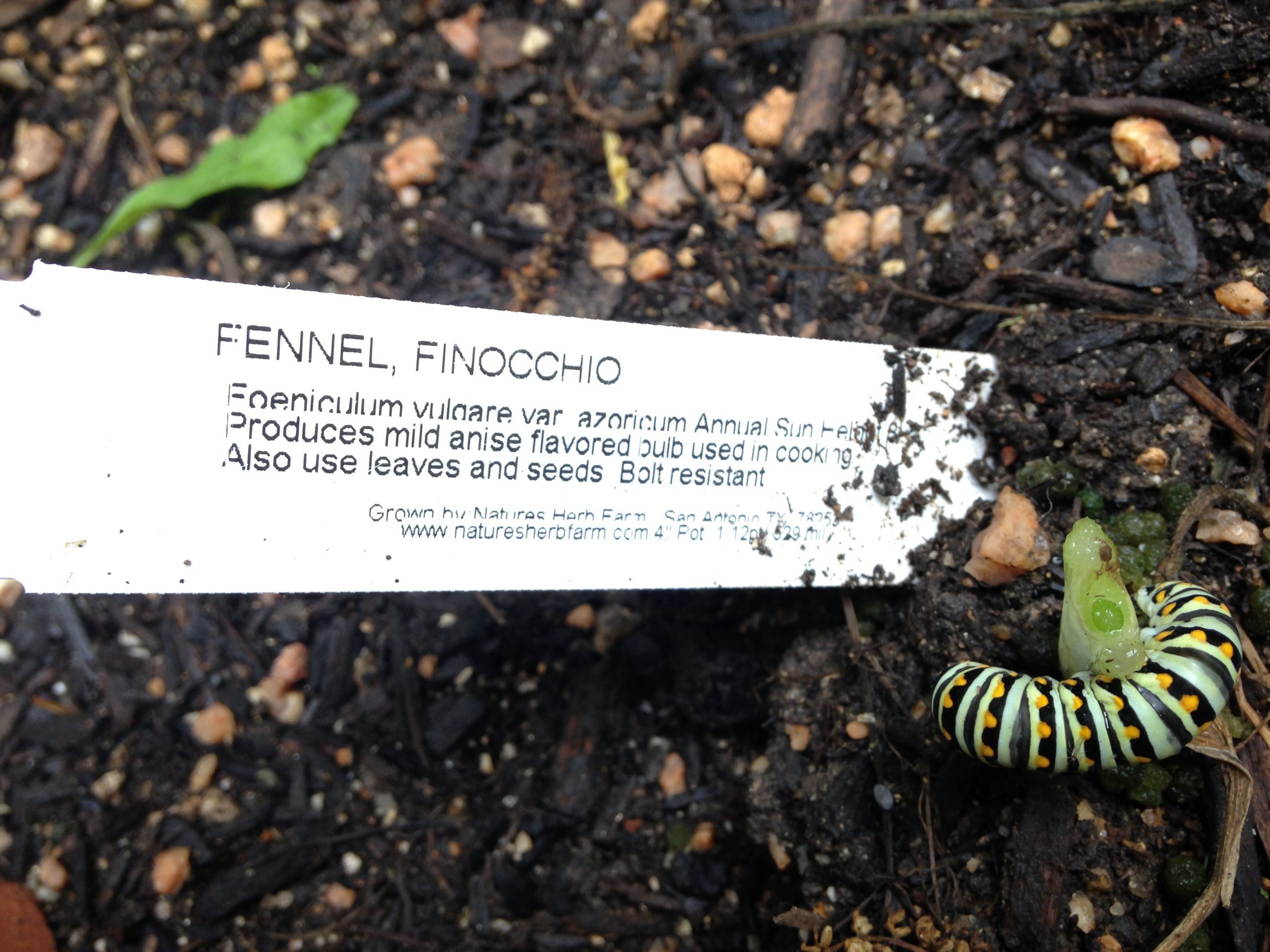
Down to the nub! Swallowtail caterpillar devoured three new Fennel seedlings. Photo by Monika Maeckle
How to Raise Eastern Swallowtail Butterflies at Home
Monarch butterflies get all the press, but the Eastern or Black Swallowtail, Papillio polyxenes, a large blue, black and gold and cream-specked beauty, flies in our neck of the world from April through November. The Texas native provides lots of action in the garden when Monarchs are elsewhere.
We've been getting questions about raising Swallowtail butterflies in recent weeks. The wet June has made for a long season for dill, fennel, parsley and rue the plants on which Swallowtail butterflies lay their eggs. Below are tips for raising them at home.
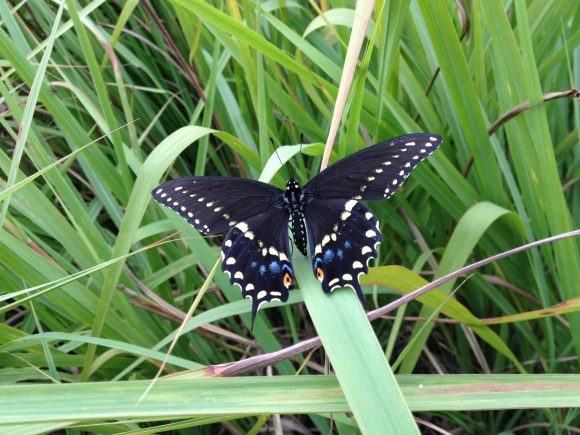
Eastern Swallowtail, recently hatched, resting in the grass. Llano River, Texas Hill Country. Photo by Monika Maeckle
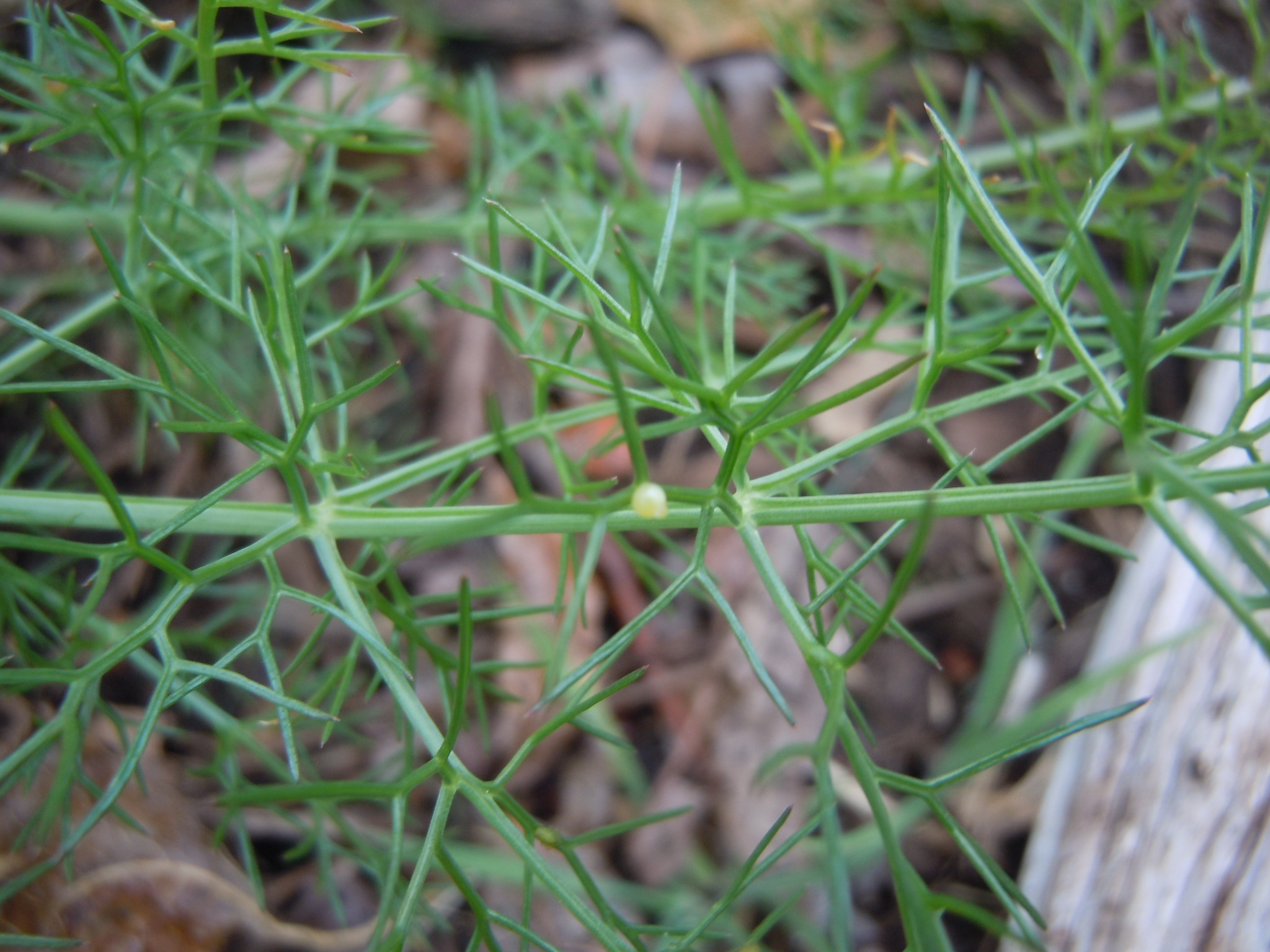
Eastern Swallowtail egg on Dill Weed. Photo by Monika Maeckle
First, locate the eggs. The tiny yellow spheres perch prominently on the leaves of dill, fennel, parsley and rue. Check your plants frequently, as wasps, ladybugs, spiders and others will slurp up these protein pops as soon as they are spotted.
When you're looking, you may notice some clear, dry, empty spheres, exactly the size of the eggs. Those are empty egg shells already visited and consumed by predators.
I usually snap off a piece of the plant with the eggs on them and take them inside to rest in a jar with the lid loosely closed. Don't worry about "smothering" the egg. They'll do fine until they hatch, usually within four days.
Once the little guys hatch, you'll want to provide fresh air to prevent mold from growing on the host plant. Bring in some sprigs of fresh plant and put them in the jar. I usually leave the eggs alone until the caterpillars are big enough to spot with a naked eye–generally two days.
You'll see they're tiny and hard to monitor, so again, leave them alone and just provide fresh air and fresh host plant until they grow bigger.
After a few days, you'll see a small black creature, perhaps 1/16th of an inch long. If you look closely, you might notice a white or orange band in the middle of the body.
That's your first instar, or stage, Swallowtail caterpillar. They will eat quietly and consistently for several days before they morph to the next stage. They're rather nondescript and not yet as interesting as they will become. Just wait.
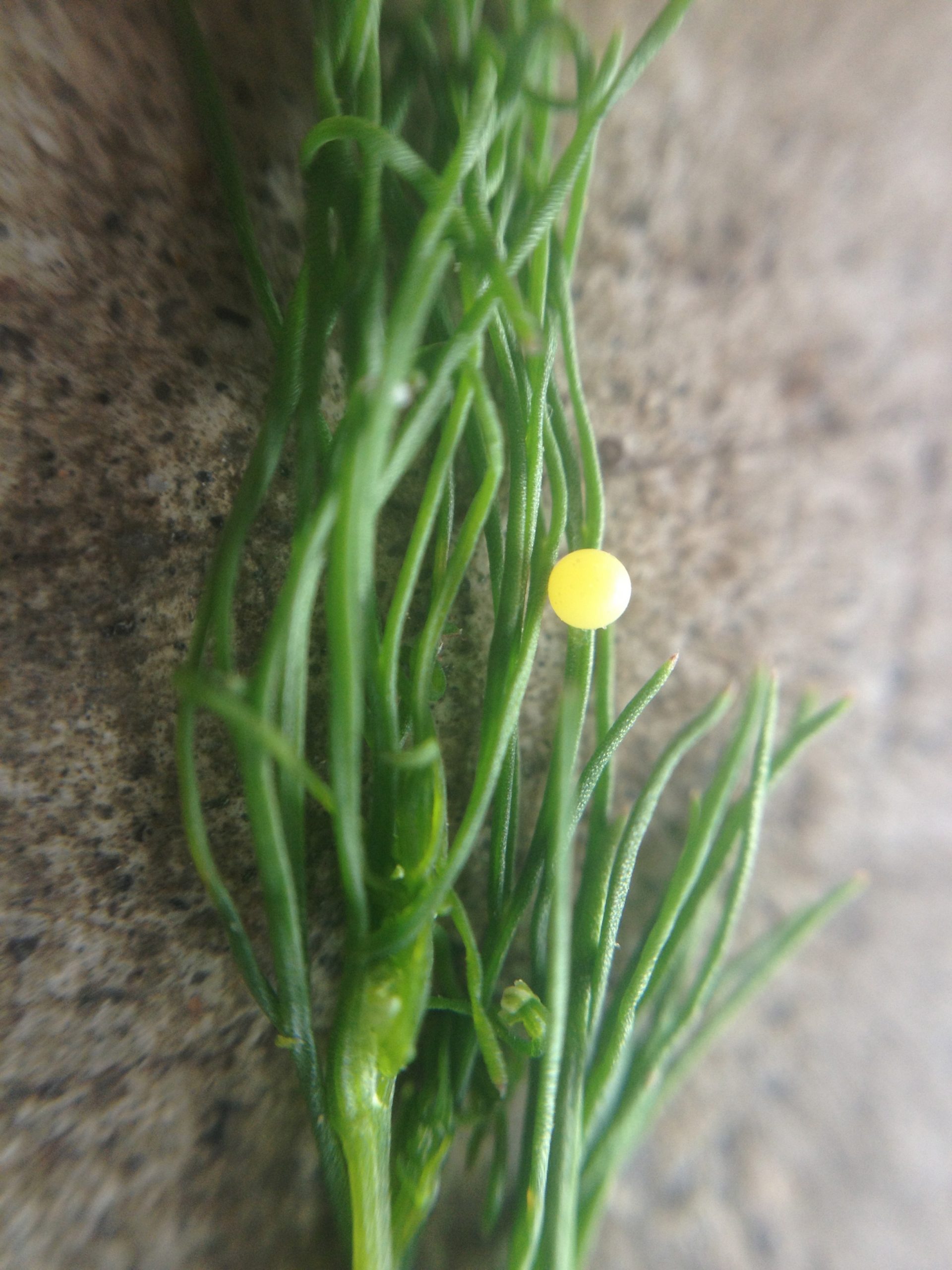
Close-up of Swallowtail egg on dill. Photo by Monika Maeckle
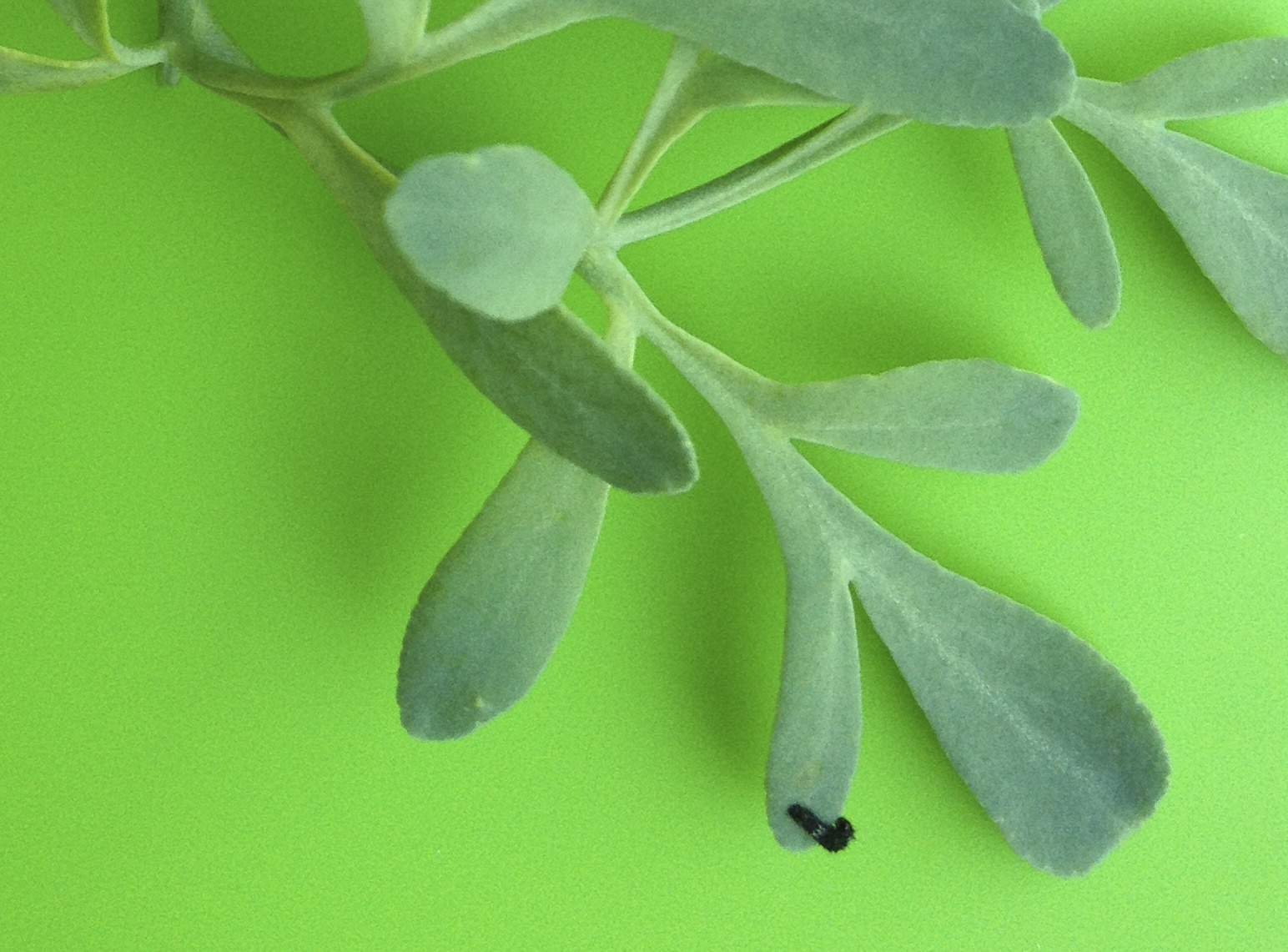
First instar Eastern Swallowtail caterpillar on rue. Photo by Monika Maeckle
Up until this point, I may have had the Swallowtails in a jar or container with a loose lid or netting. But now it starts to get interesting and I like to watch them eat and grow, although it can make a small mess.
Usually I gather fresh host plant and put it in a vase with newspaper underneath so I can observe the caterpillars literally grow before my eyes. The newspaper catches the frass, or caterpillar poop, that the caterpillars produce in volume.
The small, black odorless pellet-like droppings may seem gross, but they're actually not. Well, maybe for some people. Generally I will set such a vase in a highly trafficked place in my home or office so I won't miss the action in the course of any day. (Yes, I've been known to take caterpillars to work.)
The caterpillars will continue to eat and morph for about 10 days. What's amazing is how different they look at each stage.
As they move through their instars, they completely transform, going from the unremarkable black cat with a white band to a prickly orange, white and black form, then to a black, green, yellow and white-striped creature often confused with Monarch caterpillars.

Bouquet of Swallowtail caterpillars in vase on fennel. Photo by Monika Maeckle
Throughout the process these boys eat voraciously–lots of fresh host plant. In our hot Texas summers, I find dill expires early in the season but that Swallowtails will easily transition to the more abundant and heat-hardy rue or fennel.
At the ranch we have wild parsley and I have brought that home for feeding. Once I bought organic fennel or parsley at the grocery store to feed a slew of Swallowtails when I had run out of fresh host. The caterpillars didn't seem to like it much (like us, they prefer FRESH greens) but they ate it in the later stages.
One of the most amusing aspects of raising Swallowtails is their interesting tentacles. When they get to the last stages, they show distinctive yellow antennae when poked or bothered.
This orange forked gland, called the osmeterium, shows itself when the butterfly perceives danger. Upon the slightest nudge or threat, the yellow tentacles pop out of their head and emit a distinctive, sickly sweet odor. Kids are always impressed when you provoke the Swallowtail's tentacles.
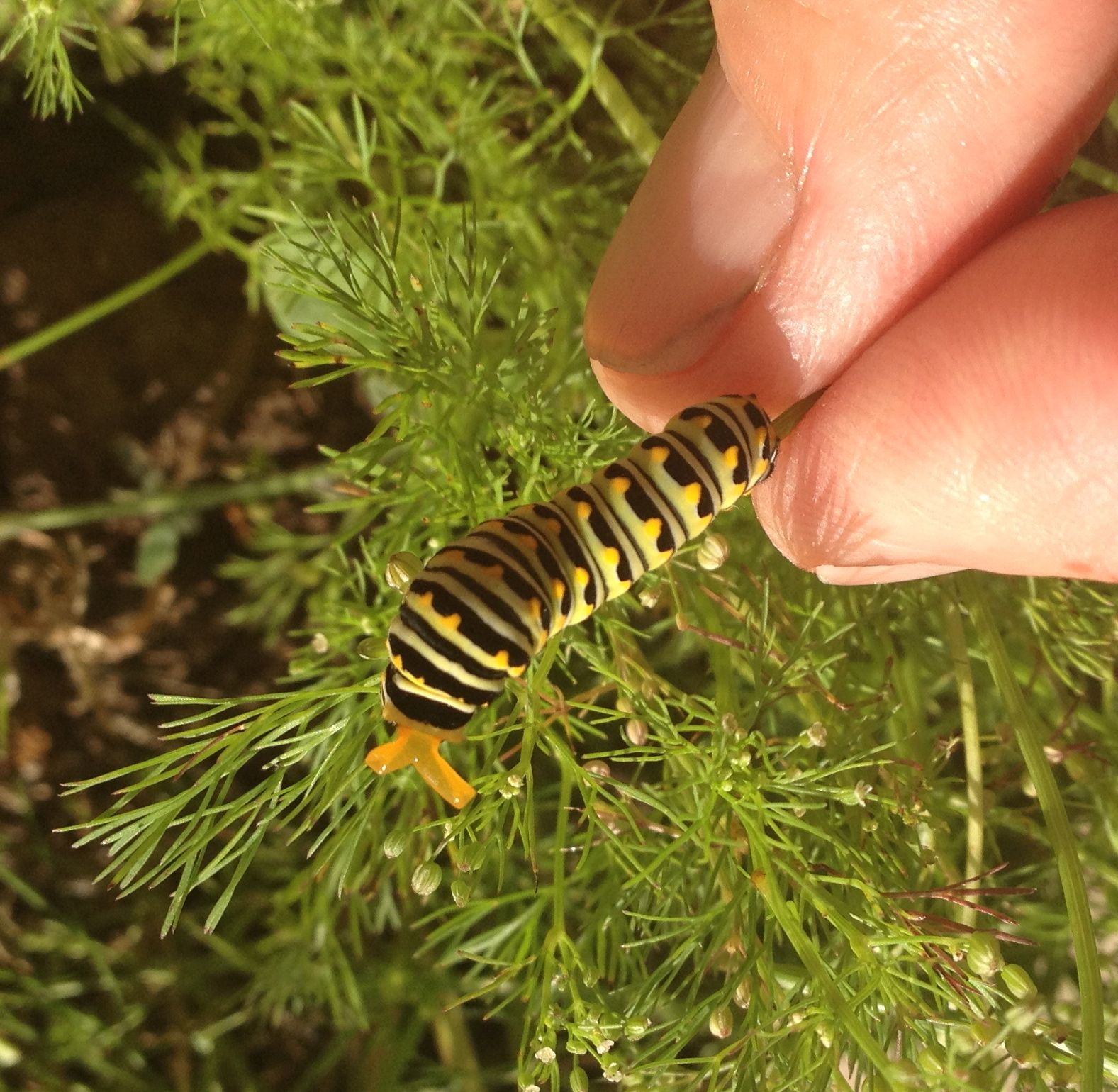
Who goes there?!? Note the yellow "tubercles" which the Swallowtail shows off when bothered. Monarchs don't do that. Photo by Monika Maeckle
The caterpillars will continue to eat, shed their skins and morph to the next stage over about 10 days until they get to the fifth instar at which time they will cease eating and seek a quiet place to form their chrysalis.
Swallowtails are famous for wandering far from the host plant and taking their time to emerge from the chrysalis at unpredictable times. Monarch caterpillars are generally reliable in taking 10-14 days to eclose, or make the transition from chrysalis to butterfly.
Swallowtails, in contrast, can take a few weeks to many months to emerge. Their unpredictability is also manifested in the varied color of the chrysalis that results from the final morphing. Sometimes brown, sometimes green, you just never know what color a Swallowtail chrysalis will be.
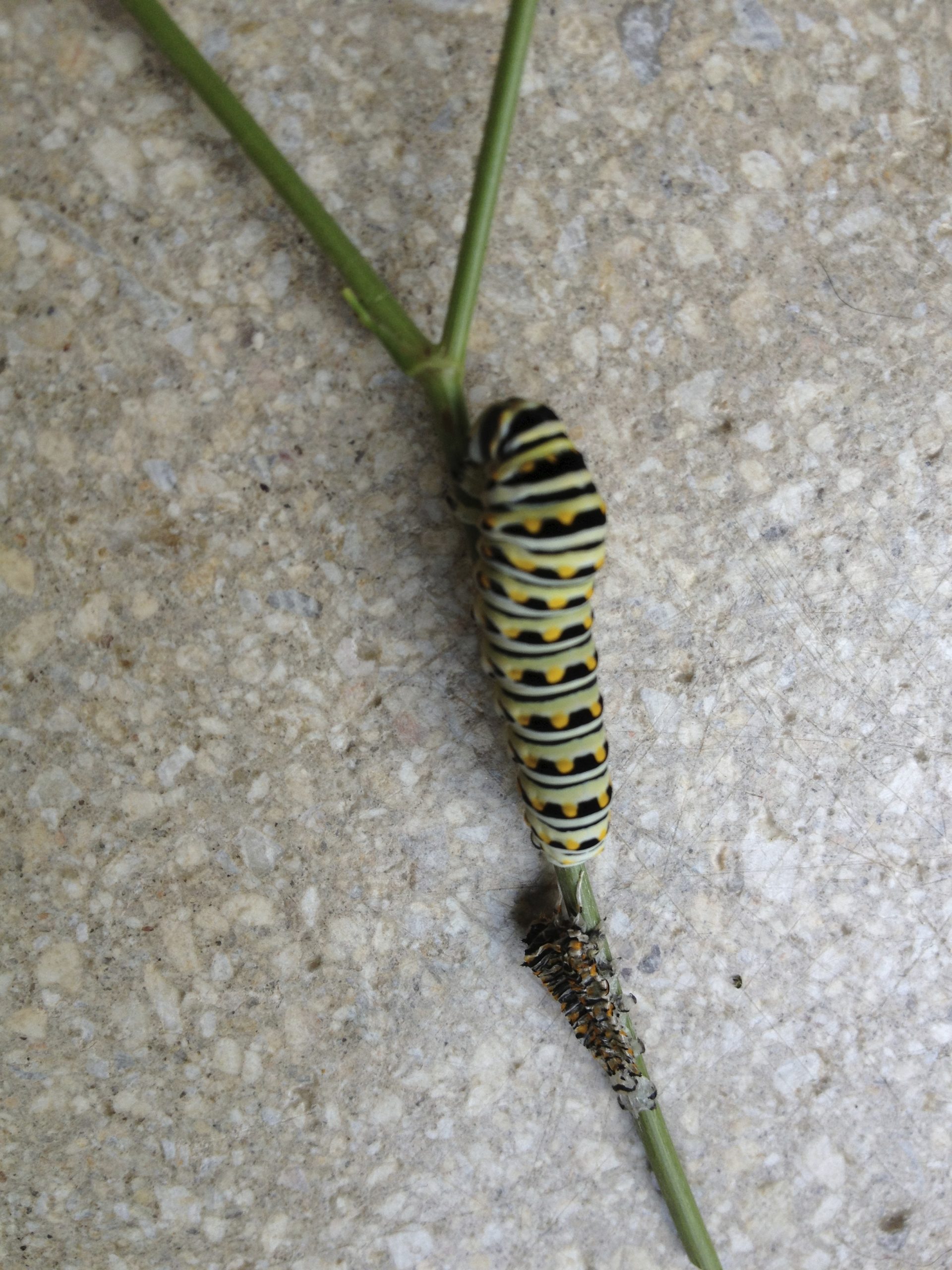
Swallowtail sheds skin. Photo by Monika Maeckle
Because Swallowtails can wander, it's smart to contain them in a cage when they get large enough to bust their stripes and go chrysalis. I use a net laundry hamper and simply put the vase inside.
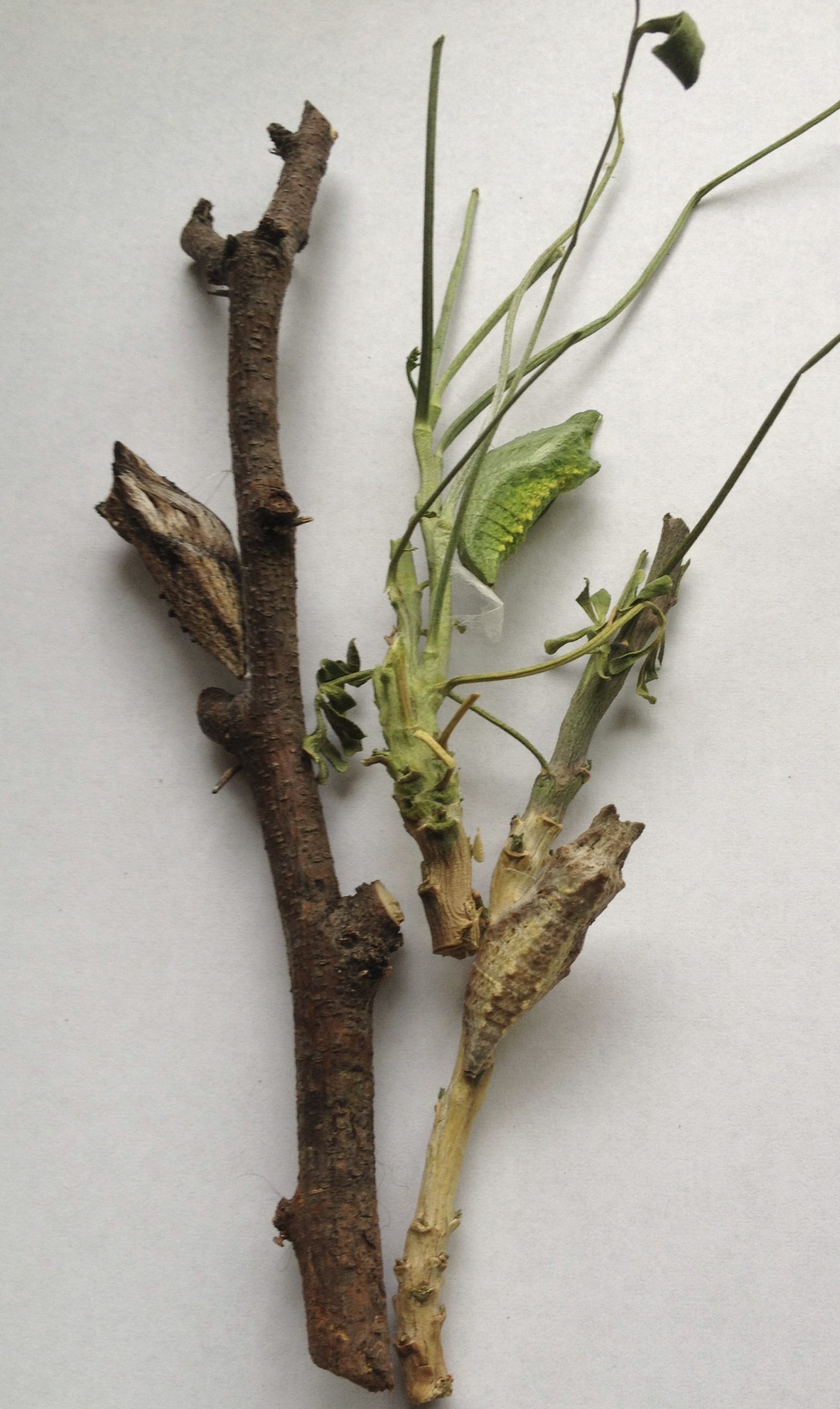
Swallotwails wear chrysalis coats of many colors. Photo by Monika Maeckle

The Swallowtail will bow its head and make a silk button and saddle before going chrysalis. Photo by Monika Maeckle
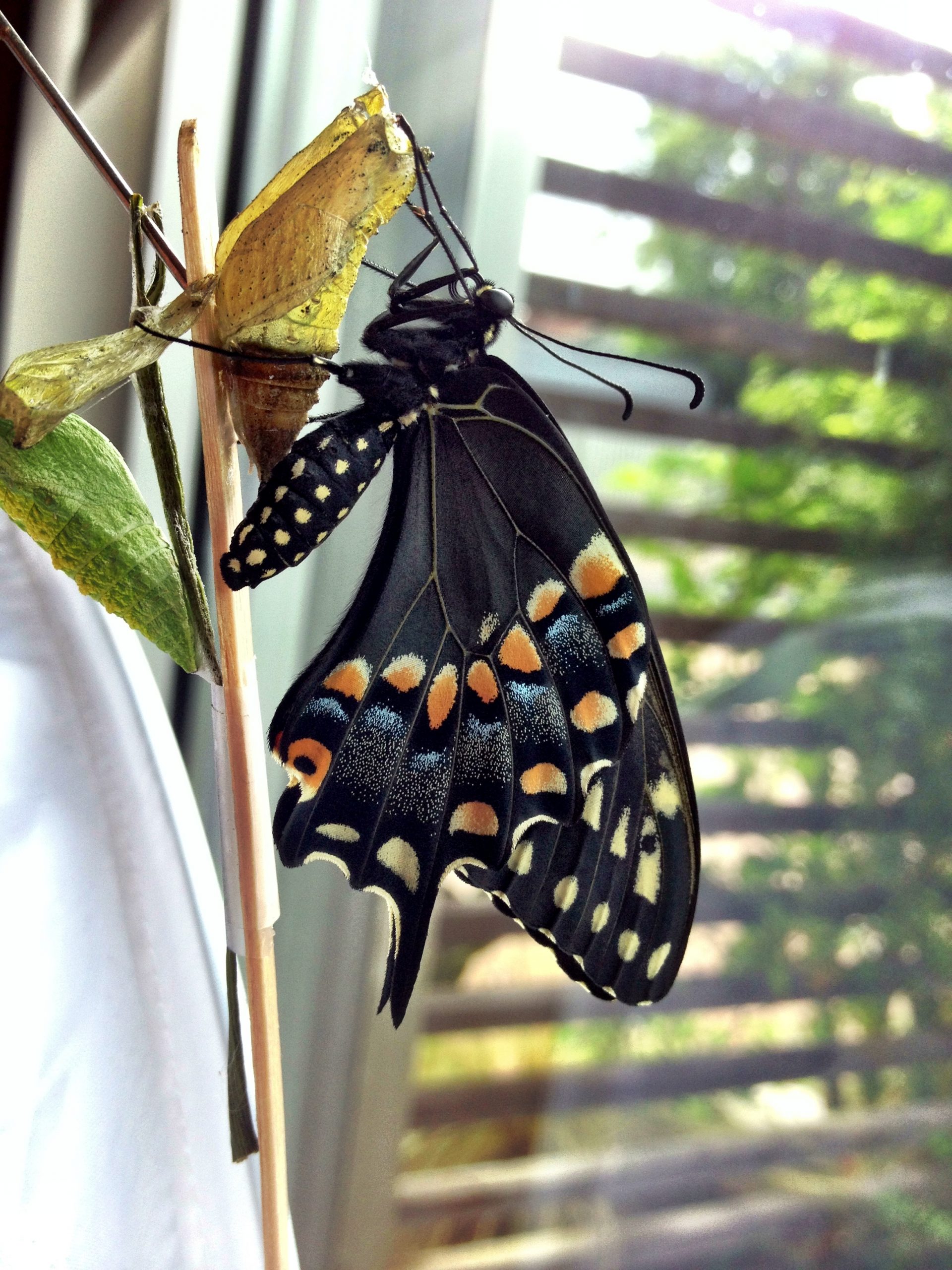
Newborn Swallowtail butterfly with sister chrysalis. Photo by Monika Maeckle
The Swallowtail, when ready, will stop eating. He will bow his head in an upside down J-shape, and spin a silk button to attach itself by its head to a twig, branch or net siding. He then makes a silk saddle to hold itself snugly in place for the time it takes to transform its DNA into a butterfly–again, an often unpredictable amount of time. Some Swallowtails will overwinter to the next season, depending on the conditions present at the time of forming the chrysalis.
When the day finally comes, though, you will know because the chrysalis will turn dark, then clear. Thereafter, the Swallowtail will emerge when ready.
Give it a few hours to allow its wings to harden. When she starts beating them slowly, you know she's ready for flight. Take her outside and send her on her way.
Like what you're reading? Follow butterfly and native plant news at the Texas Butterfly Ranch. Sign up for email delivery, like us on Facebook, or follow us on Twitter, @monikam.
Share This Story!
How Big Does a Black Swallowtail Caterpillar Get
Source: https://texasbutterflyranch.com/2015/05/14/eastern-swallowtail-butterflies-everywhere-heres-how-to-raise-them-at-home/
119 Comments
cats are so interesting, i love watching your photos transform thanks xx
Do these grow in california too? Should I be planting this type of fennel?
In California the swallowtail that is here is called a anise swallowtail they eat the same type of food but the butterflies look differently at the moment I am making my own habitat for my swallowtails.
What do the qdult butterflies eat? And can the survive during the winter?
I want to create a good garden spot for butterflies especially the Monarch. I know the Monarch prefers milkweed. Where can I buy milkweed?
Get milkweed at any nursery or Lowes or Home Depot
But make sure it's clean—that is, chemical free and never been sprayed with insecticides. Ask the nursery.
we have been keeping swallowtails for a few years now. Located in central ontario, I've always been curious as to where the butterflies go. This year , 1 of our chrysalis , over-wintered, covered in ice and snow all winter, it's now very much alive ( it wiggles). I'm excited to see the butterfly. I'm just not sure of if they migrate?
It is now getting cooler and I had a Black Swallowtail chrysalis outside with hopes that it would winter over. Recent I noticed a tiny hole in the side, about the size of a small sesame seed. Is there any chance that the butterfly emerged, or has the chrysalis been attacked by a predator?
Predator. There is a type of wasp that lays its eggs on the leaves. When the cat eats these eggs, the eggs hatch when the cat is in its chrysalis and eats/kills the chrysalis and then they create a hole and come out.
If eggs are found and I pull a piece of the plant with the egg and put it in the house in a container, do I need to keep the plant stem moist? And how do I do that?
NOt necessarily. Eggs should hatch in a few days. But you need to have fresh host plant available for them to eat when they hatch. Good luck!
I'm a butterfly breeder and every year we raise these after the second round we have crashing. Any suggestions ?
I really enjoyed reading about the Swallowtails, Monica. Thank you!
I love this article!! Great pictures… And you are not crazy to take them to work with you! I have done the same thing. 😉
Loved reading your article. I have many milkweed plants in my yard and always have Monarchs flying around. I'm going to start planting rue, fennel and parsley for the Swallowtails. I have large dill plants but have never seen eggs on it. Is cilantro a host plant, also?
Darlene
We have always had good luck with the dill in S.E. Michigan. However the past 2 years have been lesser than usual in both the Monarchs and the Swallowtails.
Wonderful article. I'm currently on my third "crop" of swallowtail caterpillars. I take bunches of fresh organic parsley in a small vase, and let them chomp away. My question is how do you handle the occasional case where a caterpillar falls off the end of a stalk onto the paper below the vase? Unless they look to be ready to chrysalize, I pick them up and replace them on their food. Do you do that too, or let 'em fend for themselves?
I have cats contained eating parsley. They are over ten days old. Should I place the cage outdoors? I'm worried indoor air may be too dry and they need to acclimate to outside.
I keep the parsley in a container of water, so the environment isn't very dry. Even though I'm pretty new at this, I've raised 2 crops of cats all the way to adults, and I think keeping them indoors and away from predators is a huge advantage for them.
I planted a pot of dill on my porch and recently noticed the caterpillars on it. There were 3 now I've got two. They're looking pretty plump for early Jan but it's been pretty warm in SoCal and they have eaten their way through most of the stalks. There's a few stems left. Assuming they'll just hang out they're done?
I gave 9 swallowtail chrysalis from September and only 1 has emerged. Should I do anything to help them. Must or put outside? Temps are 70 today in Perry ks
I have had so many cats this year. They have eaten down 2 dills and no one has anymore here in north Texas. So I still have parsley and have transferred to parsley , bronze fennel and bought a rue. They have eaten the new rue down in 1 day. I had at one time 13 cats, and 18 eggs. Down to 5 large cats and lots of babies. I wondered where they had gone. It seemed like every day I would lose a couple. Though predators. But today I saw 2 leaving a full parsley plant and take off. Pretty fast across the driveway. I did get them and put them in a jar with sticks and plant material. No fresh plants. Going to grocery.
A 5 or 10 gal. aquarium with a screen lid is an inexpensive and great way to keep the caterpillars safe. I have lost 6 new ones in just one day to predators. For now on I'm I will be collecting all eggs and caterpillars that I find.
i just found 20 cats and was not sure what to do so this helped.
Great information. I have been searching your site to see if I can find tips for over-wintering Black Swallowtails. I currently have 2 in chrysalis for almost 3 weeks now. Do you have some advice on how to care for these right now? This would be my first time with the possibility of overwintering.
Thanks in advance
Debbie Garcia
Maybe must them occasionally if it's dry. They can remain in chrysalis form for months!
I over wintered five Black Swallowtail Butterflies last year. I went to a thrift store and purchased an aquarium with a screened top. I place the aquarium in my garage over the winter and in May I put the aquarium on my back patio. Within a few weeks they all hatched. I thought that it was quite an accomplishment since I live in norther New York where the temps hit minus degrees for days and we get snow by the feet not inches. lol This year I let all but one Swallowtails go to nature which was a mistake. The one did hatchand fly away
we till our dill /garden under late fall and sow a green crop for the winter. If I collect the dried plants where should I hang them? In the barn? We live on the state lines between NC/SC Piedmont area. Thank you!
It's the beginning of August and one of mine hasn't turned into a chrysalis yet. Should I be worried?
They're VERY unpredictable. Patience. How long has it been and where are you located?
I live in NY and am on my second crop this summer. This is the first time I noticed a second batch of eggs and there were nearly 30 of them! I enlarged by make-shift pavilion around my host planter by using a camping mosquito net (instead of the screening I used previously) and put large tomato spikes to support it and for them to use as a chrysalis stick (all the natural branches/twigs aren't tall enough evidently and they just ignore them). I have 5 in chrysalis mode but sadly two others seemed to struggle so much finding their happy place, I found them just laying on the bottom of the netting outside the pot where they were trying to hook on and it looks as though they just gave up and died. So sad! 🙁 I also found two others almost under the host plant pot which is large but they aren't hooked on either so I'm wondering if they gave up too. Really sad. 🙁 Finally, I have one more I'm worried about that did hook onto the bottom of the planter but I'm afraid it might get hurt emerging. Can I move the chrysalis by removing it from it's attached spot or should I leave it alone? I also have one attached to the netting and I don't want it to hurt its wings either! Such dilemmas for this butterfly mamma from NY. Any advice is welcome. Thank you so much!
Great article and so informative. We are seasoned Monarch raisers, but unfamiliar with the lovely swallowtails.
It is sept 24 I have 17 catapillars outside in a butterfly cage what do I do for the winter.
Thank you
Vinnie
I have raised monarchs found on my milk weed plants. I bring them into the house into an aquarium with fresh leaves. I'd love to grow swallow tails. If I plant fennel, dill or rue (never heard of rue) will I get eggs or cats? I live in NJ and would bring them into the house so predators don't get them. If they don't emerge while flowers are available outside will keeping them indoors cause them to emerge possibly mid winter with no outdoor food source to let them go or put chrysalis outdoors during winter so they don't emerge until there's a proper food source available outdoors? Any info will be greatly appreciated.
I'm in NJ and was wondering if you ever found the answer to this. I have about 25-30 chrysalis and its sept 16. I'd consider driving them south if it would help.
I raise swallowtails and they lay eggs that hatch into caterpillars on my parsley and rue.
Thanks for the help, tips and advice!
This page has been very helpful and informative and thankfully with-OUT being overly wordy and annoying!
You got right to the point and gave nuttin' but the facts, that is awesome, rare and so appreciated!
Anyway, It's now Monday, 10/05/2018 and I've just finally brought in a nice sized Black Swallowtail Caterpillar that I've watched eat up my Parsley plants over the past two or three weeks!.
When I spotted him a couple weeks ago, and almost missed him in my Parsley, it was my very first time ever finding one of this species here!
I've lived in the same New York City home with my family here for 45 years now where we've grown veggie, flower and herb gardens every year since the Spring of 1973, soon after we moved in, and this is the first year that I'm seeing these Black Swallowtails up here, their color is so amazing!
It was also the wettest and coolest Spring, Summer and now Fall here as far back as I can remember!
It just finished raining here today and is due to rain here again tomorrow!
Normally we only get 'cats' around here that turn into those plain old annoying moths that plink off the porch light all night long and Monarchs and I kinda thought it was odd to find caterpillars this far past Summer, as the they have usually all turned into Butterflies and flew off by now, but after reading this page, it seems it's kinda normal to find these guys still in their caterpillar stage this late in the year.
I'm going to attempt homing him indoors till he turns into a beautiful Butterfly and will probably just let him roam the house once he can fly, since by then it would probably be too cold for him to live outside, plus I'm thinking that food sources for him would probably be all gone by Winter time.
I have a spare, empty 10gal fish tank that I can set up for him.
I was thinking of putting a dirt/soil substrate in the tank along with some Mulberry, Fig and Cherry tree branches and leaves and lots of Parsley.
Question; Should I not throw any of that stuff mentioned above in, or should I throw anything else in that he would like or need?
Any help or advice would be greatly appreciated!
And you are right these guys do poop a LOT and the "pellets" they leave aren't all that small in relation to their size!
This little guy is about the size and length of my pinky, so I was very surprised to see him drop a BIG one (the size of a green pea!) out like it was nothing! hehe
I know I'd be "hurtin' for certain" if I ever "pinched a loaf" THAT big in relation to MY size!
It would probably have to be about the size of a basketball and I'm sure that wouldn't go all too easily!
HA!
Hey! Good luck to you guy' who are also trying to raise these amazing little critters!
I have 17 catapillars in all stages outside in a cage, and I had a black swallowtail lay more eggs on my parsley today, if you are going to raise that butterfly inside it is going to be very hard you really need flowers or a sugar and water mixture for food. They can overwinter. Good luck
Vinnie
I have a dozen eastern swallowtail chrysalises created by cats from my garden fennel (which they completely ate) in a screen tent in my living room (fed on carrot greens etc). the Chrysalises have been created in the last seven to ten days. It is October 5th here in Washington DC with daytime temperatures in the 70's and 80's and night time temps in the mid 60's. Should I await eclose indoors and then release the butterflies or put them outside to either mature/eclose or winter over? What is best practice under these conditions?
October is pretty late. I'd let them winter over outside. I had a late season inside one decide it was time in january when it was 5f outside. It did last over a month on flowers and honey/water but they really need to be outside making more butterflies. Last summer was a banner year for them on flat and curly leaf parsley a hundred or so miles north of you. Next year I'll probably net over a parsley plant, a bunch of caterpillars got picked off by predators.
I have about two dozen caterpillars on my now stripped dill plant. Should I cover them with netting so they dont get eaten? Or get a habitat and put the whole plant in it?
[…] of the pollinator garden. Learn all about how to raise a black swallowtail caterpillar from this Texas Butterfly Ranch article! We await a visit from these beauties every spring on our potted fennel and plant many carrot […]
Help! One of the new formed chrysalis is no longer strung up on its dill branch. My guess is another ate through it. Can I save this chrysalis? Can I prop it somehow? HELP!
I believe you can leave the chrysalis on the ground. I sometimes put them on a paper plate and put the plate on the table that is located under a covered porch. I currently have two chrysalis that i placed in the bottom of a potted plant in the covered patio. I live in Florida. I know if they are plaxed in a garage the chrysalis can dehydrate, maybe you could mist it with water every day to prevent dehydration.
I gently laid the chrysalis on a soft bed of dried dill. It hatched fully developed! I was so happy!
I live in Florida and had many black swallowtail caterpillars outside eating fennel. Then they were all gone except for one crysallis on the fennel. In our recent rains the crysallis fell down . What do I do. I put it in the garage but I don't know what to do. I don't have a patio. I have a sunroom (air-conditioned) with lots of windows. I found two small caterpillars on basically stripped fennel today so I moved them to some fennel in my back yard. I don't want things eating the caterpillars but don't know if they would like a/c or what to do.
Thanks.
Help! I just wrote a question and your program think I wrote before. I've never seen this website before. I had a lot of black swallowtail caterpillars that got really large on several fennel. Then they all disappeared (I'm hoping they made chrysalises somewhere. I only saw one chrysalis on the fennel only held on by 2 threads. Last night it rained really hard and the chrysalis fell down. I brought it tinto the garage. I don't have a patio . I do have an air-conditioned sunroom. What should I do. I also found 2 small caterpillars today on basically stripped fennel. So I cut off a the piece they were on and carried it to a fennel plant in a raised bed I have. What can I do to protect the caterpillars. I don't have a patio. Help.
You have to protect them with a butterfly cage or the birds will them all I found out the hard way they ate over fifty of mine but now I protect them. It is also good to overwinter them in. I overwintered 11 from last year.
I have found chrysalis 70ft away from my host plants before. they formed all around my window sills and under my gutters.
This is my first year planting a small butterfly garden with milkweed, fennel, parsley, lantana, and zinnias; I'll soon be adding a butterfly bush and purple coneflowers. I've already had one monarch visit and lay eggs, but so far no swallowtails. I've noticed that at least two different types of wasps are very attracted to the fennel flowers, and I'm concerned about them predatating on any potential swallowtail eggs or cats. I'm thinking maybe I should just cut off all the fennel flowers in hope the wasps wills top hanging around?
Hi,
I have a swallowtail butterfly in my garden (now in chrysalis) that I'm protecting with some netting designed for the purpose. I was wondering if it would be safe now to remove the netting or if birds are likely to eat the chrysalis. I'm concerned about the butterfly getting caught in the netting when it emerges. I've spent hours searching, but most of the tips are about raising the swallowtails in indoor enclosures. Any advice here about when to remove the "Zippered Caterpillar Rearing Sleeve" would be welcome!
I put mine in a 15$ Reptile tank wit a screen lid from the pet store. As there are many predators in my yard. I have a screened in porch I keep the tank in. Then just release when they are ready to go!
I had two caterpillars on Queen Ann's Lace plants. I contained them in a large screened container and left them outside. One was about 1 1/2 inches when it went into the 'J' position. The other was larger, about 2 inches long. It was close to fresh food and some bare thin branches. It remained on a branch for nearly 2 days, then started to get smaller and smaller. I checked the following day and it had fallen off and was laying on the soil about 4 inches below. What could have happened?
I wonder if it was infested with teachings fly maggots? I had something similar happen to a monarch caterpillar and found the threads and pupae of tachinid flies beneath.
I have been raising Black swallowtails & Monarchs for about 4 years now & recently recruited a friend who had an interesting looking butterfly from what she thought was one of her Black Swallowtail caterpillars. It looks like a cross between Black swallowtail & Tiger swallowtail, but is clearly not a tiger, since it grew up on parsley. Is is just a Black swallowtail variant or possibly a hybrid?
I have photos.
Could it be a male? Makes and females have slightly different colorations, the male having more yellow and the female more blue
For anyone considering raising black swallowtails consider the problem I currently have. Last year, late in the season, I noticed worms on my parsley and researched them and decided they were black swallowtail caterpillars. It was really late so I brought them inside, fed them and they went into chrysalis over winter and I happily released them when they hatched in the spring. Well, I so enjoyed that I planted MANY pots on my deck with parsley seed – lots of huge pots and I was rewarded with many new caterpillars. So, all summer I have been collecting and raising the caterpillars in mesh hampers. Unfortunately, I didn't take into consideration what I call the multiplication factor. I've raised and released somewhere around 40-50 beautiful caterpillars so far, but of course, the females are looking somewhere to lay eggs. In spite of all the parsley I planted in huge pots, I don't have anywhere near enough since a female can lay up to 100 eggs. I now have some pots with 50-60 hungry caterpillars on most plants and am going to the store daily to buy bunches of organic parsley to feed them since the parsley doesn't grow fast enough to keep them fed. So, frankly I have a problem I created. I don't know that I can continue buying 6-7 bunches of organic parsley daily for another couple months. Yet I feel guilty because I am responsible.
These caterpillars/larvae also enjoy Wild Carrot, also known as Queen Anns Lace. In my area these wildflowers grow in open fields, roadsides or any natural area. My garden is full of them. Hopefully they're abundant in your location.
Vicky have they been ok with the organic parsley from the store? I am brand new to this, I created a small herb garden in a tiered plant stand this year. Didn't even know BS were attracted to dill until a friend posted about it. Sure enough I have about 7 Instars. I want to take them into a mesh enclosure but with one small dill plant and another small parsley plant I'm afraid this won't be enough food & know I'm going to have to buy organic store bought parsley & dill. No place has plants to buy this late in the season. I have been reading all I can and I know it needs to be organic produce but was told even then it could contain BT which is a pesticide approved for organic use but still harmful. Yet I've read other posts where organic produce has been fine. Debating whether to leave them on the plants where they are or enclose in mesh.
Bt is actually a bacteria harmful to caterpillars. I did use an organic parsley last year for Biko, my third caterpillar. I rinsed it thoroughly and dried it off before giving it to him. He ate it just fine and it didn't harm him.
I've had great success with organic parsley. Just be sure you are buying from a source that says their organic vegetables are certified organic. For me, the two I buy from in my area are Kroger and Harris Teeter. I did buy three organic dill plants and put them in one pot but those were eaten to the ground in about a week. I bought those pop-up mesh hampers to use as enclosures and they are working well for me but the cheap ones I bought don't have tops so I use a towel on top so the wandering ones won't crawl out (had that happen before I started covering with a towel). Good luck. It's so rewarding every morning when I feel them because I'll usually find between 3 and 4 ready to release.
Thank you so much! This is very helpful. I bought the same collapsible enclosure so I will definitely cover with a towel. I was concerned about covering from torrential rains too. They are small Instars in a vase in my house at the moment. Late yesterday they stopped eating and all day today until early evening didn't move or eat. I was concerned they were dying but then it looks like they molted and then started moving around and eating again. So exciting watch!
I keep my mesh hampers with them inside so I don't know about the torrential rains. They are, after all, outside on their own if we aren't trying to save them but I would think the towel that covers the hampers would get soaked during rain and probably fall down on them in the hamper. Next year I think I will look for some mesh hampers that have a zippered top so I don't have to worry with the towels. A local garden center held a butterfly workshop on saving monarchs and they had the mesh hampers with zip tops in their display. I have four hampers and some of them have formed their chrysalis attached to the towels. I have to be extra careful when removing/replacing the towels so I don't knock them off.
One other comment. If you don't enclose them somehow, you will likely go out one morning to find them all gone. They have numerous predators. That happened to me with one of my pots which had about 30 caterpillars. I read somewhere that said if you plan on raising them, bring in or enclose as soon as you see the instars before they become food for another animal. That's why I prefer to raise them inside in mesh cages.
Hi, has anyone who raises caterpillars using a mesh habitat experienced situations where the caterpillar's silk does not adhere to the mesh? Recently, I used my mesh habitat for the first time (but not my first cat) and the caterpillar, a black swallowtail, attached himself just below the top corner of the mesh. He was ok the day he attached himself but the following morning, I saw that the silk pad and harness had come off and he was hanging by the button. Once he started moving, the last of it let go and he fell. By some miracle he's alive (it was not a short drop). So, now I'm wondering if this is a common risk when using this kind of enclosure.
I used to put sticks in the mesh hampers for them to climb up on but it was a constant hassle every time I would clean their cage to get the sticks all standing up again. I finally stopped and they climb all over the mesh and attach where they feel like it. They've all hatched so far. I have accidentally knocked one loose when cleaning the hamper and had read about reattaching it. I took a piece of thread (although a piece of paper towel will work also) and using hot glue attached the thread to the stick. I then, using an extremely small amount of glue, attached the tip of the chrysalis to the thread and let it sit until it was dry. I propped the stick back in the hamper so when the butterfly emerged he would have enough room for his wings to unfold and dry and it worked great. He emerged with no problems.
I forgot to mention – there are videos on Youtube on reattaching chrysalis.
Thanks for the information. I was worried that Nikki's falling meant that they couldn't properly attach to the mesh. It's good to know that most do succeed. I'm not sure if rehanging is an option anymore since he lost his silk harness and pad when he pupated.
As in another of your articles, you have misnamed the swallowtail. Papillio polyxenes is, as your useful link in paragraph 5 says, "Black Swallowtail" NOT "Eastern Swallowtail". Please correct this. It will confuse people, as there is an "Eastern Tiger Swallowtail" but no such thing as an "Eastern Swallowtail". Butterflies are confusing enough without supposed experts using the wrong names.
Do you really think that it's rude to correct misinformation in a post and a website that claims to be educational???
Making a correction can be done with diplomacy rather than a critical sarcastic tone.
Several of us have tried to correct the misinformation on this page and another related page. We have been ignored. Is that polite? Does that show consideration for the readers or for scientific accuracy? If you read my comment again without your strangely antagonistic attitude, you will see that there is no sarcasm. A straightforward correction with reasons given.
My earlier comment remains valid.
The University of Florida Entomology Department may be respected for some things, but in this case someone there made an error, which has unfortunately not been corrected. The North American Butterfly Association is the best source for butterfly common names in the U.S., the Canadian Biodiversity Information Facility in Canada. If you look up Papilio polyxenes, the species in your articles, you will find the Black Swallowtail is the official common name in all the sources I checked (except UFL). All my field guides use this name; they obviously did their research regarding names. There is a subspecies that may be called "Eastern", Papilio polyxenes asterius; you'd be correct in referring to that one if you used the quotation marks. Most of the people reading your articles here are obviously not familiar with species. Wouldn't it be best to use the correct and nearly universally-accepted name and not have them get it confused with Eastern Tiger Swallowtail?
It is not rude for someone to ask the writer to provide correct information.
Everyone makes mistakes.
Good job , Miss Carolyn for catching it and requesting the correction 🙂
Thank you Miss Melinda. I find it quite distressing when people come to this page to learn and they're being given the wrong name for the butterfly, one that confuses it with other species. Butterflies are confusing for beginners, as it is!
One of my butterflies hatched and we release her. But the second one has not hatched. We are wondering if it's dead. How can you tell
Is your chrysalis a Monarch or a Black Swallowtail, and how long has it been a chrysalis? Has it changed colour at all?
I am raising monarch caterpillars in a net cage outdoors, feeding them milkweed. I just noticed a dozen fat swallowtail caterpillars on my dill. Would it be OK to put them and dill in the same cage with the monarchs?
I am having a problem. I have noticed that my Black Swallowtail chrysalis' abdomen is turning brown. It's a green chrysalis and it is just the lower sections of the abdomen that have turned brown. It has become worse this evening than this morning and I noticed this starting yesterday. Given the season here (I'm in Canada) he's supposed to overwinter as a chrysalis and has been one for 22 days so far. I tried that test of moving the abdomen and seeing if it retakes its position and it still does however it's harder to move than before. Can anyone tell me what may be wrong with him?
Any update? They seem to be emerging too late in the year here in Canada (Ontario) – one came out October 2nd (please see my post).
Hi Richard, thank you for asking. Unfortunately, Nicky died the next day. I am not sure what went wrong. Ok for your situation: Yes it is definitely too late for that female Swallowtail to have a brood. According to the book, "The Butterflies of Canada", The Black Swallowtail caterpillars are active outdoors only until mid-September, thus they should be overwintering in their chrysalises after that point in time. Also, the flight season for the adults ended at the end of August. To encourage diapause the caterpillars and the chrysalises have to perceive Autumn. If they get less than 14 hours a day of light exposure, that can encourage diapause. Also cooling temperatures are another natural cue of seasonal change. If you were raising them indoors, exposure to artificial light after sunset may contribute to making them "think" that it is still summer and then they will not diapause. To keep them in diapause and survive the winter, they must be exposed to cold temperatures. One option is to put the chrysalises in the fridge until next year's flight season (which begins in Canada around mid-May). Some people have a lot of success with this, but you'd have to worry about either the fridge dehydrating them or about too much humidity. It's best to read up on exactly how to proceed with that. The other option is to place them in an unheated garage where they will feel the cold, but be sure to place their container/ cage where mice can't get them. I don't know if the same applies to giant Swallowtails. I hope this helps. Thanks again for your interest.
We have had a very good year for Eastern Black Swallowtails up here in Ontario, Canada – we have collected around forty eggs from a singe rue patch and had very few losses. Now the problem is that it's already October 2nd and the last butterfly of this year's crop came out today – a lovely female. BUT, it's very doubtful that she will be able to being off a successful brood so late in the year – frosts can start any time – does anybody know of a way to 'persuade' them to stay in their chrysalis until next year? For, example keeping them in the fridge for a couple of weeks maybe?
Right now we have three one week old Giant Swallowtail caterpillars (from the same rue patch) and we're anxious that they don't emerge this year so the question also applies to them.
I've been raising black swallowtails in my classroom for years. They usually overwinter until may or june but this year one emerged on February 26. If I release it now, it will surely die (it's been a warm winter in Connecticut but still way to early for flowers).
Can I feed it sugar water in my classroom until it's a better time to release it? Is that bad or wrong to do? Should I just release it and let nature run its course?
Also does anybody know what triggers them to emerge? I always assumed it was the amount of daylight but could never find the answer.
Thanks for the advice!
Hi Kurtz,
I read a while back that you can make a nectar using sugar and water. One part sugar for nine parts water. Boil the water and dissolve the sugar in it while it boils. Cool that down and it can be used.
As for what causes diapause to break: the amount of daylight is the right answer. They need 14 hours of daylight a day to emerge. Artificial light such as indoor lighting can affect them. So if you want a chrysalis to stay in diapause it can't have too much exposure to any kind of light. Many sources state that temperature plays a role but not all experts seem to agree. One thing I did read is that exposure to cold temperatures is necessary for a chrysalis to stay in diapause and survive. That's why people always say to store them in the garage or fridge.
I hope that this was helpful. Good luck with your Swallowtail.
Hello! I found one of these on a pile of rocks trying to come out if it's chrysalis. Obviously had fallen from the above. It was stuck and struggling…
Took the chrysalis off.
The left wing looked wrong and was hoping it would recover. Tried feeding it sugar water etc. it would not eat.
Are some just born not to live?
Some are born and can't fly. Even though I successfully raised and released about 50 last year, I had about a dozen overwinter as chrysalis. This spring they all hatched out but a couple came out with damaged wings. I put them in my butterfly condo and cared for them until they died (about 17 days). I would soak cotton balls in honey water (10:1) or punch flavored Gatorade which they loved. I had two at one time that I was caring for and I believe they came to recognize my voice. They would be clinging to the side of the mesh condo and when I would come in and start talking to them (without touching the cage) they would let go and drop to the bottom of the cage. I would pick them up and set them on the soaked cotton balls and let them stay for a good while to eat before putting them back on the side of the condo – until time to feed again.
What a lovely story. I too had a male emerge after wintering in the garage with a damaged wing. I tried orange juice in a tea light candle holder but found the best was the lid of milk container – nice and shallow. He came to know me too and was very comfortable on my fingers and hands. He did the best drinking when I set him down on a paper towel in front of the filled milk lid and he happily drank for quite a while. It was the first time I saw the proboscis fully used and it was just amazing to watch him clean it afterward and then tuck it back up like the bottom of a g-clef symbol! After that he started demonstrating trying to fly a bit and eventually he did fly away so don't give up hope if a wing is damaged – they may be able to overcome it!
Please could you post a photo of your 'mesh cage' it's late October in Italy and I'm bringing a caterpillar in to shelter from heavy rain.
Can you raise the black swallowtails in jars?
Here in Eastern Pa. my son and I have recently had seven caterpillars go into chrysalis. We're anxious to see them hatch out..Three have been in chrysalis for two weeks and the others have just gone in. We also have about ten babies.
I think your butterflies may winter over in chrysalis and not come out until the spring. Perhaps someone with experience raising them in your area could say for sure. Swallowtails need a long enough warm season to mate, lay eggs and go through all their caterpillar instars to go into chrysalis, in which they spend the winter. They only have time each summer to go through 2 cycles in the northern U.S.
If they are going to wait until the spring, you may want to keep them in natural temperature and light conditions so that they don't come out too early.
Hello! I currently have around 7 caterpillars! and a few eggs. Since it is August 11 and they are not yet even in their chrysalis. Should I make sure their daylight is monitored? So I can keep them over the winter? Like keep them in my shed and close the doors before it is past 14 hours of daylight?
I brought several black swallowtail caterpillars from my dill, parsley and fennel plants indoors. I now have a 5 chrysalis and 10 caterpillars in various stages. The earliest chrysalis is 20 days old but hasn't eclosed. Could the temperatures indoors (~72degF) have caused it to go into diapause (but its only August)? Or could the air conditioning indoors have caused it to dehydrate? Or is it normal to take that long to eclose? The 2nd oldest chrysalis is a week old and is green, while the 1st, 3rd, 4th and 5th are all brown. I am in North Carolina.
As the story states, they are highly unpredictable. Be patient. Could take months. Try to mimic natural conditions as much as possible. Good luck! —MM
Hi, also tried you on FB. I have an Eastern Black Swallowtail that emerged this morning, but his wings are folded back and he can't fly. I want to cry. I put him in a bushel basket with a begonia plant and added a sunflower that recently bloomed. I'm trying to figure out how best to keep him .. he won't survive outside. He moves around quite nicely, it's just his wings. Any suggestions are most welcome, and I am continuing to scour the web for more info. Who would have thought I'd become so darned attached to the little guy!
It's tough, but I would probably put him in the freezer and out of his misery. I know you don't want to hear it, but Nature is cruel. In the wild, we would already be a goner. Good luck! –MM
In early spring, I had 8 that had "overwintered" in their cage. When they emerged two of them had wing problems and couldn't fly. I, too, couldn't kill them so I kept them in their cage and fed them daily. I had read somewhere that they are particularly fond of fruit-flavored Gatorade. So, I would alternate between honey water (10:1) and the Gatorade – making sure they always had either of them available (on soaked cotton balls). I had also read that in the wild the average lifespan of a black swallowtail is approx. 14 days. Mine lived 16 and 17 days. I think they came to know me because every morning and night when I would change their food I would talk to them. After a while when I would start talking (without touching the cage) they would release from holding onto the side of the cage and drop to the bottom – as if they were anticipating more food. I was sad to see them go.
I have a swallowtail chrysalis in a half gallon mason jar with a mesh netting on top. What should I do to provide moisture to the environment. What
Keeping a folded up moist paper towel in there that I can change out everyday?
Please please please… Do not use"ORGANIC"store bought fennel, dill,etc…I did last year when I ran out in my garden and killed 16 BST CATS overnight… Organic is bullish… It may not have pesticides, but it almost always has herbacides… What the farmers and crooked govt call"natural pesticides"…. It's for killing the same thing we're trying to raise and protect… And who knows what it does to us and our children and pets?
There are many reputable websites that sell real organic feed for caterpillars… Don't even buy organic for yourself
Wow! This is so helpful! I found a bunch of first stage cats on some parsley I was harvesting and not knowing what they were, I picked out these leaves to send them to the compost… but after reading this, they're now sitting in a vase on the porch. 🙂 Thanks for the great info!
Love this! I have a cat that has been eating away at my fennel. It has now stopped and is sleeping. Should I move him?
It's better not to disturb him. Perhaps he's going to shed his skin? If he needs more food, he'll go looking for it. At that point you could move him, but let him follow his instincts as much as possible.
He may be pre-shed. They stop moving for about a day beforehand. It's important that he not be disturbed.
I've been without Angelia since my last garden and finally bought plugs this Spring. Just notice three eastern black swallowtail caterpillars in two tiny Angelica! So if you're looking for host plants, this biennial would be a nice addition. Plus you can candy the stems.
I have 9 swallowtail cats currently munching on organic store bought fennel and dill (yeah sorry that's all I have available to me..it was eat that or starve). They showed up in a raised bed that I had cleaned out except for a rogue Rue plant and some hot peppers. I stumbled across them. Had I not, they would have been left to mother nature and their own devices.
They're getting pretty big. I put a mesh laundry basket over them. My question is…will they climb the mesh to the "roof" or should I add sticks of some sort inside the basket.
One of the best and my favorite blog ever.
One of the best and my favorite blog ever. Aala stuff and best quality.